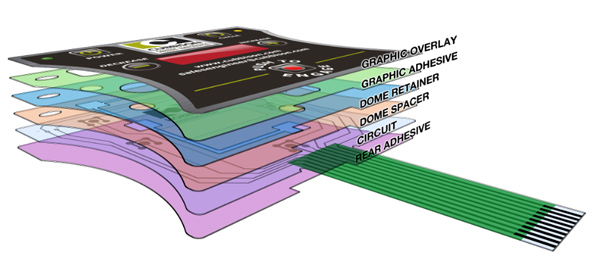Recognizing Membrane Layer Switches: The Secret to Reputable and durable Controls
Membrane switches represent a critical facet of modern user interface design, mixing functionality with resilience in numerous applications. As we check out the ins and outs of membrane buttons, it becomes clear that their duty in enhancing control systems is both complicated and extensive, elevating questions regarding just how finest to leverage their capacities in future developments.
What Are Membrane Layer Buttons?
Membrane switches are an innovative solution in the realm of interface modern technology, integrating capability and design perfectly. These gadgets act as a user interface between customers and digital systems, incorporating several components right into a portable layout. Commonly constructed from adaptable, slim layers of materials, membrane buttons are created to reply to touch, making it possible for users to connect with machinery and electronic gadgets successfully.
The key elements of a membrane layer switch consist of a printed circuit layer, visuals overlay, and a spacer layer that avoids unexpected activation. The visuals overlay can be customized to reflect brand identification or individual choices, improving aesthetic appeals while making sure use. Membrane layer buttons are generally utilized in different applications, including medical gadgets, customer electronic devices, and industrial tools, owing to their resilience and resistance to environmental aspects such as wetness and dust.
One of the essential advantages of membrane buttons is their ability to hold up against damage, making them suitable for high-traffic atmospheres. In addition, they are light-weight and call for marginal room, allowing for innovative layouts in item development. In general, membrane switches over represent a sensible and efficient selection for modern-day electronic interfaces, marrying modern technology with user-centric layout principles.

How Membrane Changes Job
The operation of membrane switches rest on a straightforward yet efficient system that converts individual input into electronic signals. These buttons are composed of several layers, normally consisting of a graphic overlay, a spacer layer, and a circuit layer. When a user presses the button, the top layer warps, permitting a conductive aspect in the circuit layer to reach an equivalent conductive pad on the bottom of the graphic overlay. This call shuts the circuit and sends a digital signal to the device, suggesting that the button has actually been activated.
The style of membrane layer buttons can differ, but they usually incorporate domes or tactile components to offer comments to the user, enhancing the overall experience. The products made use of in membrane buttons, such as polyester or polycarbonate, add to their longevity and resistance to ecological factors, including moisture and dirt. The printed circuits are commonly enveloped, which protects them from wear and tear over time.

Advantages of Membrane Layer Buttons
One of the main benefits of membrane layer buttons is their versatility in style, permitting them to be personalized to satisfy certain customer requirements and aesthetic requirements. This adaptability reaches different industries, where various forms, sizes, and colors can be employed to improve user interaction and aesthetic allure.
In addition, membrane buttons are recognized for their resilience. Built from robust products, they are immune to dust, dampness, visit this page and physical wear, which dramatically extends their lifespan compared to conventional mechanical switches. This resilience makes them specifically appropriate for high-traffic atmospheres and applications needing durability.

Additionally, membrane layer switches use a structured profile, leading to a thinner layout that can be integrated into different gadgets without adding bulk. This function not only enhances the visual appeal however additionally adds to a much more ergonomic item style.

Applications of Membrane Switches
Functional and user-friendly, membrane buttons find applications throughout a large range of industries, including clinical tools, consumer electronics, and commercial equipment. In the clinical area, these switches are important to gadgets such as diagnostic devices, client tracking systems, and mixture pumps, where reliability and convenience of cleansing are vital. Their ability to keep and stand up to rough settings functionality makes them excellent for such applications.
In customer electronic devices, membrane buttons are made use of in products like microwaves, cleaning makers, and remote controls - membrane switch. Their smooth design permits user-friendly interface, improving the total customer experience while giving toughness and resistance to damage
Commercial equipment also benefits from membrane switches, particularly in control panels for equipment and automation systems. These switches offer defense versus dirt click here to read and dampness, guaranteeing constant efficiency in challenging settings. Moreover, their adjustable attributes allow suppliers to customize them to particular functional needs, enhancing efficiency and performance.
Choosing the Right Membrane Change
When selecting a membrane layer button, it is crucial to consider different aspects that affect efficiency and suitability for specific applications. The main considerations consist of environmental problems, tactile feedback, toughness, and style requirements.
First, examine the operating atmosphere; switches subjected to dampness, chemicals, or extreme temperature levels require certain products to make certain long life and functionality. Next, evaluate the need for tactile feedback. Depending upon individual interaction, some applications might profit from a responsive reaction to verify activation, while others might like a non-tactile layout for aesthetic reasons.
Durability is an additional critical aspect; membrane layer switches must be designed to withstand regular use, influences, and abrasion. Ensure the chosen switch can withstand the anticipated lifecycle, especially in high-usage circumstances.
Final Thought
In final thought, membrane switches offer as crucial parts in the layout of trustworthy and resilient control systems throughout various industries. The versatility of membrane switches over enables for tailored solutions that fulfill specific functional requirements, strengthening their relevance in contemporary innovation.
Membrane layer switches over stand for an important facet of modern-day interface layout, mixing performance with strength in different applications.Membrane switches are a sophisticated solution in the world of user interface modern technology, incorporating functionality and style perfectly. Commonly constructed from adaptable, thin layers of products, membrane switches are created to react to touch, enabling individuals to interact with equipment and electronic devices effectively.
The style of membrane layer switches can vary, yet they commonly include have a peek here domes or responsive elements to give responses to the user, boosting the general experience.In verdict, membrane layer changes serve as vital components in the layout of resilient and dependable control systems throughout numerous markets.